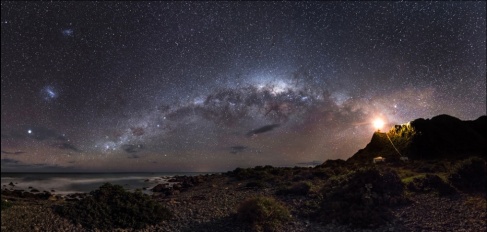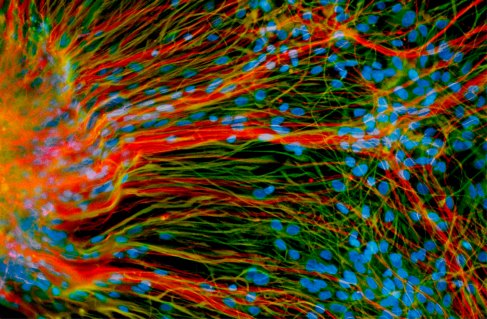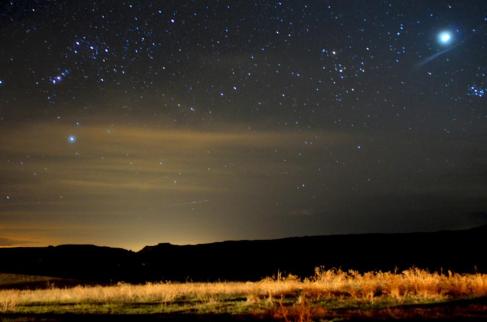INTRO:
We have hit a dead end. It is as simple as that. The culmination of 3.5 billion years of biological evolution, the epitome of millions upon millions of mutations and adaptations, the magnum opus of mother nature, we stand here today at the top of the ladder. There is nowhere else to go. There are no more rungs to scale. This is it. Or so some would tell you. Others, however, might shake their heads and laugh at such hubris. To think that we are the epitome of life, given everything we have observed about our universe, is to think that the human race has somehow transcended the laws that govern existence- everything from physics to biology to simple chemistry. Many argue that we are still evolving today, still changing and adapting to new conditions in our environment. In his novel Dune, Frank Herbert depicts a future in which the human race is intrinsically linked to its own evolution, both intellectually and physically, and has come to rest at the brink of a startling new phase of our species’ existence.
SUMMARY:
Set on the notoriously hostile desert planet of Arrakis, Dune follows the story of young Paul Atreides, the heir to House Atreides, which has recently been entrusted with control of the planet by the leader of the Galactic Imperium. Forced by political pressure to move from their lush home world of Caladan, Paul, his mother Jessica and his father Duke Leto uproot their entire household and their followers to take up residence on their new, barren fiefdom. Jessica, a member of the secretive organization known as the Bene Gesserit, is warned by one of her own before her departure that the offer of Arrakis is in truth a trap, a ruse contrived by the Duke’s rival, Baron Harkonnen, to destroy House Atreides and win Arrakis for himself. When the family proceeds heedlessly and does indeed fall victim of a trap, betrayed by the Harkonnen’s and the Emperor, the entire Atreides force is massacred, leaving only Paul and his mother to flee into the desert to seek refuge with the mysterious and savage natives of Arrakis, known as the Fremen.
It is here that Paul meets his destiny. It is revealed that the Bene Gesserit, to which his mother belongs, was formed eons ago with one goal: to manipulate human bloodlines and breeding patterns to produce a genetically superior individual, known as the Kwisatz Haderach, who would possess intellectual faculties capable of operating in the “higher dimensions”, and be able to extend his mind in many directions through time. In the midst of their flight to the desert, Paul has a flash of prophetic vision, discovering that he is the long-awaited individual. Paul and his mother (who is surprised as he is to learn that she has given birth to “The One”) use his new-found powers to recruit aid from the Fremen, whose religion (thanks to Bene Gesserit infiltration) prophesizes the arrival of a messiah gifted with such abilities. Paul is quickly recognized and is soon lofted up as a religious-political leader, a position which he uses to take back Arrakis with hordes of Fremen warriors, and win back his rightful title as Duke. Throughout the plot, the themes of genetic superiority and biological advancements play integral roles, which Herbert uses to state that the human race is indeed still evolving.
TECHNOLOGICAL EVOLUTION:
One of the most common claims in the debate over mankind’s continuing evolution is that, because we have become so technically advanced, natural selection no longer plays a part in our development. Instead, the technological evolution of man has risen to replace its biological evolution. There is indeed some truth in this. On Earth today, because of the advancements we have witnessed in medicine, housing and food production, life expectancies and birth rates across the globe have skyrocketed in relation to the rest of our species’ history. This has led to a more even reproductive success rate among individuals in any given population, as those who would once have died off or been weeded from the herd are now able to live fairly long lives and find suitable mates. As a result, many claim that we are no longer evolving, that we have become advanced enough to modify our environment and essentially freeze the Darwinian system that led us to our current state.
Our technology, on the other hand, has developed almost as a new species would, mutating and adapting and becoming increasingly complex and efficient. It is argued that this has substituted for the physical adaptation of man himself. Indeed, in Dune Herbert references events in the past that point to the evolution of technology, and mankind’s dependence on it. “Once men turned their thinking over to machines in the hope that this would set them free. But that only permitted other men with machines to enslave them,” mentions the Revered Mother Mohiam in a conversation with Paul, referencing the rise of artificial intelligence (Herbert, 11). It is in the same conversation, however, that Herbert departs from the classic view of technology as the obvious and inevitable next-step in human evolution.
“‘Thou shalt not make a machine in the likeness of a man’s mind,’ Paul quoted. ‘Right out of the Butlerian Jihad and the Orange Catholic Bible,’ she said. ‘But what the O.C. Bible should’ve said is: Thou shalt not make a machine to counterfeit a human mind. Have you studied the Mentat in your service?’” (Herbert, 11)
Apparently at one time before the events of Dune take place, mankind’s technology became so advanced that it posed a threat to its creators. During the Butlerian Jihad, the war that mankind waged against machines and higher technology, all computing devices were banned from the galaxy. In their place rose the Mentats, humans schooled in logic and reasoning, trained to act as biological computers.
“‘The Great Revolt took away a crutch,’ she said. ‘It forced human minds to develop. Schools were started to train human talents,’” (Herbert, 11).
With this seemingly retro-active step, Herbert creates a future for the human species in which its inherent, biological gifts are returned to the fore. “The god of machine-logic was overthrown among the masses and a new concept was raised: ‘Man may not be replaced,’” (Herbert, 485). By returning the focus of his sci-fi setting to the human element, Herbert demonstrates that our species is still capable of development, and insinuates that technology is merely a crutch, a temporary speed bump in that development. We are still adapting, he states, and with his background of mankind’s technological development laid, he continues on to an examination of our natural evolution.
NATURAL EVOLUTION:
Having studied everything from physics to ecology in his youth, Herbert had developed an impressive knowledge background by the time he began his work in science fiction. Consequently, all of his novels contain startlingly accurate systems and mechanics. It is no wonder, then, that in a galaxy-wide empire he developed complex and extensive evolutionary patterns, both social and physical. Because he established that mankind had, in part, rejected the one-track evolutionary route offered by technology, he made it possible for human adaptations to make up for the technological advances of our modern appliances. However, with the acute eye of a scientist, he noted that, despite the retro-grade technology, the relative ease of life on lush garden planets would inevitably lead to adaptive stagnation. Because of the variation in planetary environments, it is inevitable that some would present much more hostile environments than others. When this fact is combined with the “bubble effect” produced by the isolation of planetary populations, a galactic empire becomes the perfect laboratory in which to observe the process of human evolution. Thus, he took his narrative to the farther reaches of the habitable spectrum, setting his novel in the infamous sands of Arrakis.
It is an inherent law of Darwinian evolution that competition drives adaptation. In an environment with limited resources, competition will always arise in a population, leading to unequal reproductive success, and thus a selective passing-down of genetic traits. What place in the galaxy is more competitive than Arrakis? “The Bene Gesserit were well aware that the rigors of such a planet as Arrakis with its totality of desert landscape its absolute lack of open water, its emphasis on the most primitive necessities for survival, inevitably produces a high proportion of sensitives,” (Herbert, 493). Although here he refers to the evolution of quasi-psychic abilities, the statement holds true for physical adaptations as well. The extremity of the conditions on Arrakis, the harshness of the environment coupled with the constant war between rival factions, served as a planet size petri dish for the culturing of human evolution. When Paul’s mother encounters the Fremen, she notices physical adaptations in them immediately. “She tipped up the point, drew a delicate scratch with the blade’s edge above Mapes’ left breast. There was a thick welling of blood that stopped almost immediately. Ultrafast coagulation, Jessica thought. A moisture-conserving mutation,” (Herbert, 54). This is the first direct mention that Herbert makes of actual, physical evolution in humans. It is clear that he predicts the continued development of our species as a result of environmental factors. However, he does not stop there. As a result of hundreds of thousands of years of civilization and knowledge, Herbert depicts how our species might eventually turn its gaze upon itself, and actually take a hand in shaping its own evolution.
GUIDED EVOLUTION:
He embodies this idea, of course, in the Bene Gesserit.
“The Bene Gesserit program had as its target the breeding of a person they labeled the ‘Kwisatz Haderach,’ a term signifying “one who can be many places at once.” In simpler terms, what they sought was a human with mental powers permitting him to understand and use higher order dimensions. They were breeding for a super-Mentat, a human computer with some of the prescient abilities found in Guild navigators,” (Herbert, 492).
In today’s world of morally restricted politics and science, a project of this nature, the breeding of human beings, would be impossible. There would be too many objections, too many people balking at the idea of being coupled like livestock. However, in a future that has seen a war between humans and machine and the near unification of the galaxy’s religions (in the Orange Catholic Bible), the plausibility of such an endeavor would be viewed more realistically. Nonetheless, to be safe, the Bene Gesserit shrouded their organization and actions in ritual and mysticism, becoming the objects of much suspicion and superstition over the years. Their goal was wholly unknown to the outside world, and for ninety generations they worked as hidden matchmakers, arranging marriages and sometimes sending some of their own daughters to bear children of specific bloodlines.
Ultimately, their actions resulted in a kind of pseudo-evolution. By matching genetic partners to produce desired traits in the offspring, they were essentially stepping in for natural selection. “The original Bene Gesserit school was directed by those who saw the need of a thread of continuity in human affairs. They saw there could be no such continuity without separating human stock from animal stock—for breeding purposes,” (Herbert, 492). The way Herbert portrays this is almost as the third step in the human evolution. First we evolved from early hominids, naturally, then we began to rely on the evolution of technology to drive our species forward. Now we have moved on to conscious attempts to improve our genetic makeup via natural reproduction. In Dune, Herbert has sketched out an “evolution of evolution”. Granted, the motives and means of the Bene Gesserit are questioned by all, even the audience, but the end result of their machinations is undeniable. Paul Atreides, the Kwisatz Haderach, the one who can be many places at once, the man who can see through time, is the next step in human evolution.
CONCLUSION:
Ever since Darwin, humans have asked themselves whether they too are subject to the same, primeval process of adaptation as the beasts observed on the Galapagos. Perhaps it is an unwillingness to admit to a shared bond between themselves and animals, or the lofty pride of civilized society, but time and again many have rejected the possibility, claiming that we are as evolved as it is possible to get. However, all the science points to the contrary. Whether we like it or not, with each replication of parent cells there are errors made in the DNA sequence. Mutations occur and are passed down to our young. Our species is still changing, still adapting. Now, whether that change is happening in our technological society at the rates that is used to in the wild, or whether the changes being passed down today are necessarily the most beneficial to survival are questions open to much scrutiny. It is highly doubtful that we are moving along the evolutionary track at the speed or in the direction that we used to. However, as Frank Herbert has proposed in Dune, it is possible that at some point in our future we might fall back on our biological resources and witness a rebirth of the value and capabilities of mankind. We still have the potential to be the most important resource in the galaxy. There are yet more rungs to climb.









